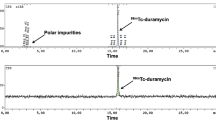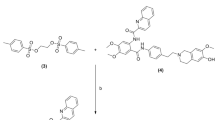Abstract
Purpose
We tested the suitability of 99mTc-sestamibi to image the inhibition of P-glycoprotein (Pgp)-mediated multidrug resistance in tumor cells and xenografts after antisense treatment and/or inhibition with a novel Pgp modulator WK-X-34.
Procedure
Pgp inhibition was measured by daunorubicin transport assays and fluorescence microscopy in resistant A2780/Adr cells treated with WK-X-34 and antisense. A2780/Adr xenograft mice were dosed with mdr1 antisense oligodeoxynucleotides intratumorally for three days; next, mice were treated with WK-X-34, followed by 99mTc-sestamibi injection. Mice were imaged, sacrificed, and tissues collected. Images and isolated tissues were analyzed for 99Tc distribution. Pgp expression was analyzed by immunofluorescence and reverse transcription-polymerase chain reaction.
Results
Both WK-X-34 and mdr1 antisense treatments significantly inhibited Pgp activity in vitro and in xenografts. Biodistribution results correlated with results from the 99mTc-sestamibi images. Mdr1 mRNA and Pgp were significantly down-regulated by antisense treatments.
Conclusions
99mTc-sestamibi is a sensitive probe to monitor Pgp inhibition by different mechanisms in vivo in tumor xenografts.





Similar content being viewed by others
References
Ling V (1995) P-glycoprotein: its role in drug resistance. Am J Med 99(6A):31–34
Piwnica-Worms D, Chiu M, Budding M, Kronauge JF, Kramer RA, Croop JM (1993) Functional imaging of multidrug-resistant Pgp with an organotechnetium complex. Cancer Res 53:977–984
Vecchio S, Ciarmiello A, Potena M, et al. (1997) In vivo detection of multidrug-resistant (mdr1) phenotype by 99m TC-sestamibi scan in untreated breast cancer patients. Eur J Nucl Med 24:150–159
Agrawal M, Abraham J, Balis FM, Edgerly M, Stein WD, Bates S, et al. (2003) Increased 99mTc-sestamibi accumulation in normal liver and drug-resistant tumors after the administration of the Pgp inhibitor, XR9576. Clin Cancer Res 9:650–656
Scherer LJ, Rossi JJ (2003) Approaches for the sequence-specific knockdown of mRNA. Nat Biotechnol 12:1457–1465
Alahari SK, Dean NM, Fisher MH, DeLong R, Manoharan M, Tivel Robinson KL (1996) Inhibition of expression of the multidrug resistance-associated P-glycoprotein by phosphorothioate and 5′ cholesterol-conjugated phosphorothioate antisense oligonucleotides. Mol Pharmacol 50:808–819
Ramachandran C, Wellham LL (2003) Effect of mdr1 phosphorothioate antisense oligodeoxynucleotides in multidrug-resistant human tumor cell lines and xenografts. Anticancer Res 23(3B): 2681–2690
Pajeva IK, Globisch C, Wiese M (2004) Structure–functions relationships of multidrug resistant P-glycoprotein. J Med Chem 47(10):2523–2533
Jekerle V, Klinkhammer W, Scollard DA, Breitbach K, Reilly RM, Piquette-Miller M, et al. (2006) In vitro and in vivo evaluation of WK-X-34, a novel inhibitor of P-glycoprotein and BCRP using radio imaging techniques. Int J Cancer 119:414–422
Tan B, Piwnica-Worms D, Ratner L (2000) Discovery of multidrug resistance transporters and modulation. Curr Opin Oncol 12:450–458
Acknowledgments
This research was supported by a Canadian Institute of Health Research Grant (MPM), the Deutsche Forschungsgemeinschaft (Graduiertenkolleg 804, University of Bonn, Germany) and the Government of Canada Award (V.J.). The authors wish to thank Shaun Ramdhany and the Department of Nuclear Cardiology, UHN, Toronto, Canada for their cooperation and support in conducting the animal imaging studies.
Author information
Authors and Affiliations
Corresponding author
Rights and permissions
About this article
Cite this article
Jekerle, V., Wang, JH., Scollard, D.A. et al. 99mTc-Sestamibi, A Sensitive Probe for In Vivo Imaging of P-Glycoprotein Inhibition by Modulators and mdr1 Antisense Oligodeoxynucleotides. Mol Imaging Biol 8, 333–339 (2006). https://doi.org/10.1007/s11307-006-0057-0
Published:
Issue Date:
DOI: https://doi.org/10.1007/s11307-006-0057-0




